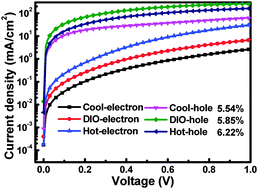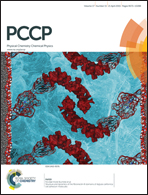Optimization of charge carrier transport balance for performance improvement of PDPP3T-based polymer solar cells prepared using a hot solution†
Abstract
Polymer solar cells (PSCs), with poly(diketopyrrolopyrrole-terthiophene) (PDPP3T):[6,6]-phenyl-C71-butyric acid methyl ester (PC71BM) as the active layers, were fabricated using solutions of different temperatures. The best power conversion efficiency (PCE) of the PSCs prepared using a hot solution was about 6.22%, which is better than 5.54% for PSCs prepared using cool (room temperature) solutions and 5.85% for PSCs prepared using cool solutions with a 1,8-diiodooctane (DIO) solvent additive. The underlying reasons for the improved PCE of the PSCs prepared using a hot solution could be attributed to the more dispersive donor and acceptor distribution in the active layer, resulting in a better bi-continuous interpenetrating network for exciton dissociation and charge carrier transport. An enhanced and more balanced charge carrier transport in the active layer is obtained for the PSCs prepared using a hot solution, which can be determined from the J–V curves of the related hole-only and electron-only devices.


 Please wait while we load your content...
Please wait while we load your content...